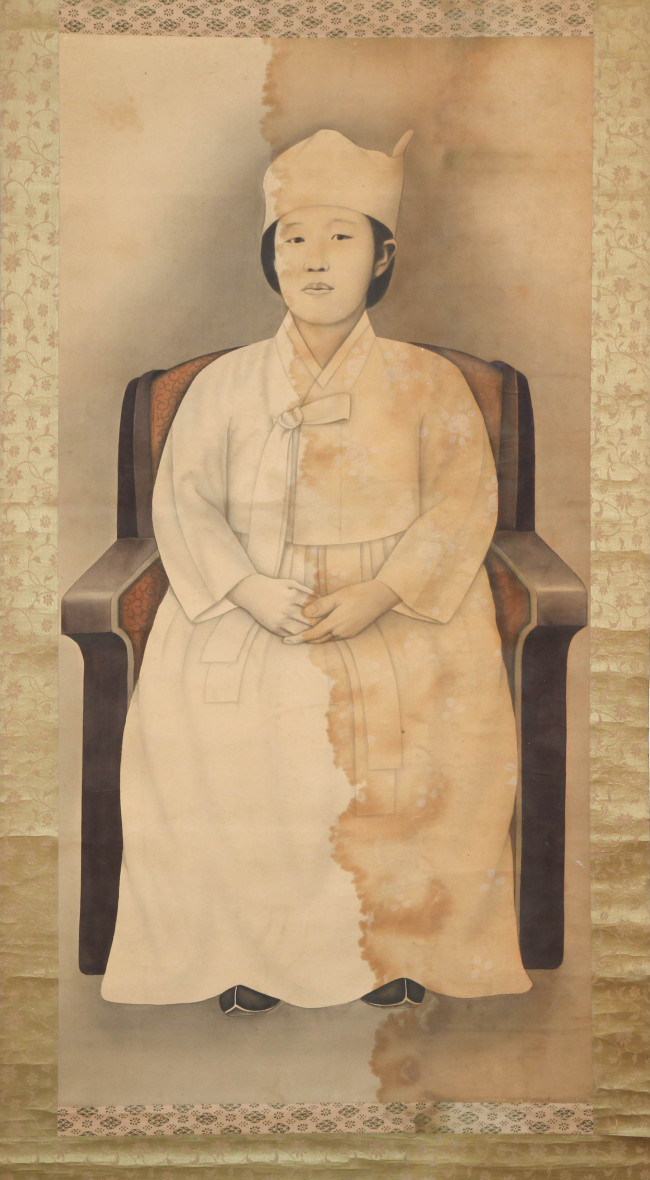A Joseon-era portrait of a woman dressed in a traditional garment is on display in Seoul, with the gallery claiming it to be a painting of the last queen of Joseon.
The alleged drawing of Empress Myeongseong (1851-95) -- also known as Queen Min -- is on display at Daboseong Gallery in Jongro-gu, central Seoul until Aug. 31. It is part of a special exhibition of 300 artifacts from the late Joseon Dynasty, which include writings by independence fighters and items used by the last royal family of Korea.
 |
A portrait of a woman, which some claim depicts the Joseon era’s last empress, Empress Myeongseong, is shown in this photo. (Daboseong Gallery) |
The exhibition marks the 72nd year of Korea’s liberation from Japan and the 120th anniversary of the proclamation of the short-lived Korean Empire (1897-1910).
The highlight of the exhibition is the portrait which, if confirmed, would make it the first-ever image of Empress Myeongseong. Although there are several photos and portraits of a woman presumed to be her, none of them have been confirmed as authentic.
The 66.5-centimeters-long and 48.4-centimeters-wide portrait shows a woman sitting on a chair, wearing a white hanbok and a headgear of some sort.
Kim Jong-chun, the gallery’s director and Korean Antiques Association chief, said that experts from various fields have assumed the woman to be Empress Myeongseong, based on the fact that such apparel was not worn by commoners during the time.
Park Bo-rim, 89, a distant relative of King Gojong (Emperor Gwangmu), said that such looks could only be witnessed inside a palace.
Kim also said that a deleted part of the writing on the portrait says “Min-ssi,” which is an honorific term that means “of Min family.” Combined with the visible words “a lady’s portrait,” the words say “a portrait of a lady of Min family.”
Insufficient proof, however, has sparked suspicion about the portrait‘s authenticity.
Kim, who claimed to have received the portrait from an anonymous collector, refused to reveal how the ink wash painting came into the collector’s possession.
Park, who worked at Unhyeongung, a royal residence, decades after the queen’s death, failed to confirm if the apparel is of the type worn by the royal family.
“As far as I know, it is not accurate. But the hat and other pieces of clothing were not worn among commoners. But I don’t know if royals had worn them, as I’ve never actually seen them,” said Park, who is not an expert on traditional Korean clothing.
Kim also refused to reveal the names of “the multiple experts” that he claimed to have consulted, saying that they are reluctant to talk to the press.
Some of the evidence he presented is self-contradictory.
When it was pointed out that a royal would never pose for a drawing in common clothes -- all the portraits of the royal family in the Joseon era feature formal attire -- Kim pointed to a record that King Gojong at one point demoted Queen Myeongseong to a commoner, and a portrait of her wearing common clothes can exist.
The queen was demoted to a commoner status two days after she was assassinated by Japanese assassins, however her status was reinstated shortly thereafter.
An expert who participated in restoring the aforementioned inscription “a portrait of a lady of Min family” said that he cannot be sure that the writing ever said “of Min.”
“It looked like it could be Min. We just carried out the restoration on the assumption that it said Min. I can’t be 100 percent sure,” he said.
(
minsikyoon@heraldcorp.com)








